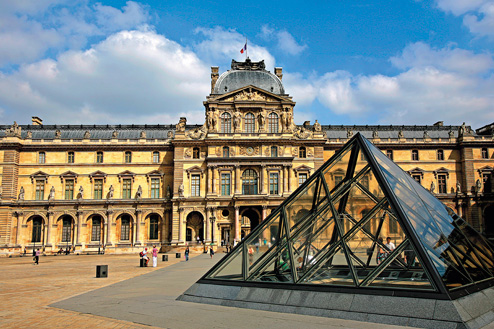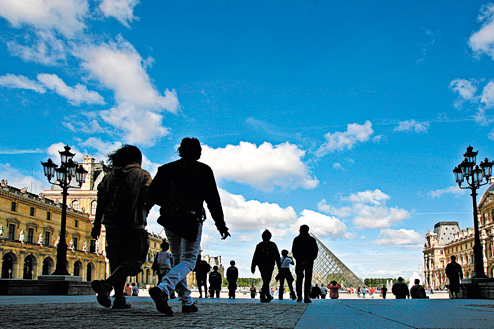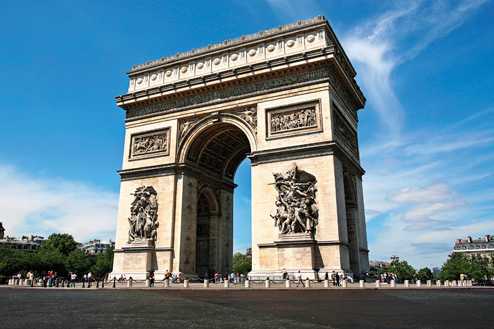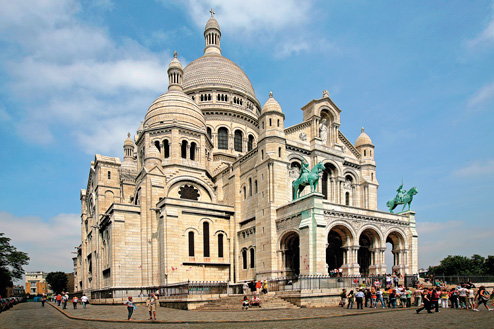Passy & The South-West
Between the Seine and the Bois de Boulogne , lies the seriously select neighbourhood of Passy. With the notable exception of the Musée Marmottan , it’s not rich in conventional attractions, but with its provincial atmosphere and architectural flourishes, it lends itself to leisurely exploration.
Tucked away to one side of Trocadéro, the Cimitière de Passy gives you some idea of the local cachet. Overlooked by the Tour Eiffel, its long-term residents include generals and screen stars, industrialists, couturiers and a good measure of aristocrats. An unpretentious grave unites the painters Manet and Berthe Morisot; Debussy and Fauré are buried here, too.
To get a taste of Passy life, spend a little time in and around the Place de Passy. With its spruce church, covered market and cafe terraces, it’s strong on village ambience, despite the abundant shopping stores close by.
Just off rue Raynouard, you’ll pass the rue des Eaux and the Musée du Vin . The street’s name recalls Passy’s heyday as a therapeutic spa from the 17th century onwards, when many springs bubbled up in the area. (Take a trip west to the fountain on Square Lamartine if you want to sample the iron-rich water from a water table 600 metres below your feet). Also on rue Raynouard, rather hidden by a high wall, is Balzac’s House . Harassed by creditors, the writer particularly appreciated the house for its easy rear escape route. Further along the same road, the Maison de la Radio is the home of French broadcasting and, on the corner, the Café à la Fontaine is a favourite spot for celebrity-spotting (assuming you know who to look for, that is.)
A late 19th century construction boom in Passy and its southern neighbour, Auteuil coincided with the ascendancy of Art Nouveau. For admirers of Hecor Guimard and his like-minded contemporaries, these areas offers rich pickings. Just beyond the Maison de la Radio stands one of the most extravagant examples. Castel Béranger (14, rue Fontaine) launched Guimard’s career in 1898, and soon became known disparagingly as Castel Dérangé. It’s a private building, though residents are well used to passers-by gazing rapt at its gargoyles, dragons, exuberant swirls and scrolls.
For something utterly different, you need look no further than the Square du Docteur-Blanche, a few streets west of here. Two very different villas designed by Le Corbusier in the 1920s are a monument to the architect’s innovative simplicity. They now form Le Corbusier Foundation and the open-plan, airy La Roche villa is open to visitors.
Continue south, and you’ll find yourself close to some of the city’s most exclusive addresses, many of which, like the knot of streets around boulevard de Montmorency, are gated. This area has several striking hôtel particuliers, whose rich 18th century facades you’ll spot between here and the place Jean Lorrain.
The largely residential areas across the Seine are less colourful than Passy and Auteuil. The area’s principal attraction is the large Parc André-Citroên , built on the site of the former car factory. With its colour-blocked flowers, yawning terraces and squirting jet fountains, it puts a decidedly contemporary twist on the French tradition of formal gardens. For a fee, you can take a short helium balloon ride above the lawns for a view of the scaled-down Statue of Liberty (an early prototype of the full-size version in New York).
Tucked away to one side of Trocadéro, the Cimitière de Passy gives you some idea of the local cachet. Overlooked by the Tour Eiffel, its long-term residents include generals and screen stars, industrialists, couturiers and a good measure of aristocrats. An unpretentious grave unites the painters Manet and Berthe Morisot; Debussy and Fauré are buried here, too.
To get a taste of Passy life, spend a little time in and around the Place de Passy. With its spruce church, covered market and cafe terraces, it’s strong on village ambience, despite the abundant shopping stores close by.
Just off rue Raynouard, you’ll pass the rue des Eaux and the Musée du Vin . The street’s name recalls Passy’s heyday as a therapeutic spa from the 17th century onwards, when many springs bubbled up in the area. (Take a trip west to the fountain on Square Lamartine if you want to sample the iron-rich water from a water table 600 metres below your feet). Also on rue Raynouard, rather hidden by a high wall, is Balzac’s House . Harassed by creditors, the writer particularly appreciated the house for its easy rear escape route. Further along the same road, the Maison de la Radio is the home of French broadcasting and, on the corner, the Café à la Fontaine is a favourite spot for celebrity-spotting (assuming you know who to look for, that is.)
A late 19th century construction boom in Passy and its southern neighbour, Auteuil coincided with the ascendancy of Art Nouveau. For admirers of Hecor Guimard and his like-minded contemporaries, these areas offers rich pickings. Just beyond the Maison de la Radio stands one of the most extravagant examples. Castel Béranger (14, rue Fontaine) launched Guimard’s career in 1898, and soon became known disparagingly as Castel Dérangé. It’s a private building, though residents are well used to passers-by gazing rapt at its gargoyles, dragons, exuberant swirls and scrolls.
For something utterly different, you need look no further than the Square du Docteur-Blanche, a few streets west of here. Two very different villas designed by Le Corbusier in the 1920s are a monument to the architect’s innovative simplicity. They now form Le Corbusier Foundation and the open-plan, airy La Roche villa is open to visitors.
Continue south, and you’ll find yourself close to some of the city’s most exclusive addresses, many of which, like the knot of streets around boulevard de Montmorency, are gated. This area has several striking hôtel particuliers, whose rich 18th century facades you’ll spot between here and the place Jean Lorrain.
The largely residential areas across the Seine are less colourful than Passy and Auteuil. The area’s principal attraction is the large Parc André-Citroên , built on the site of the former car factory. With its colour-blocked flowers, yawning terraces and squirting jet fountains, it puts a decidedly contemporary twist on the French tradition of formal gardens. For a fee, you can take a short helium balloon ride above the lawns for a view of the scaled-down Statue of Liberty (an early prototype of the full-size version in New York).













